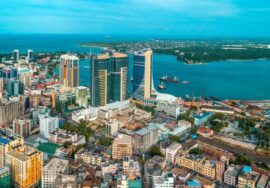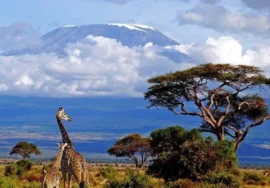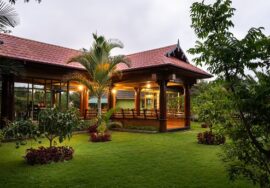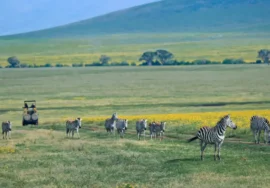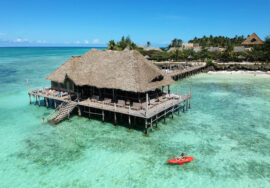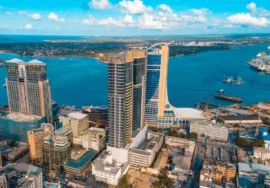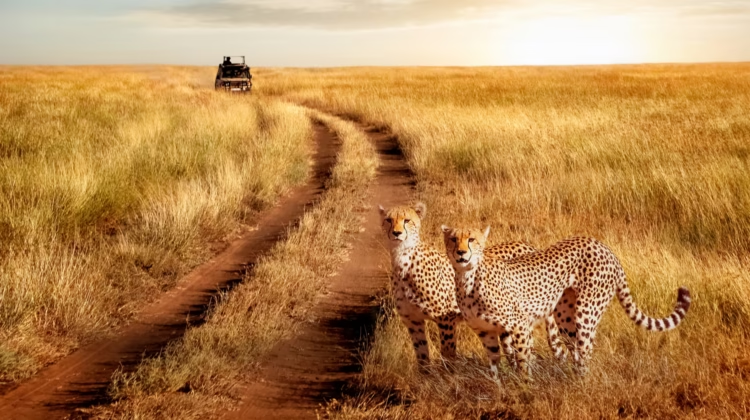
Serengeti Safaris in the Serengeti National Park
Serengeti Safaris in the Serengeti National Park. The Serengeti National Park is the most well-known park in all of Africa. Known for its extraordinary concentrations of predators and the Great Migration, which involves two million grazers, a safari in this area is certain to be one of the most memorable experiences of your life. These vast grassy plains are among the greatest grazing areas in the African wilderness, and as a result, they are home to the largest herds and the highest concentrations of predators on the entire globe.
It is one of those really uncommon places that has a large reputation, but still manages to transcend expectations and steal your breath away. The Serengeti Africa is one of such places. This wider region is particularly noteworthy from a cultural point of view because it is surrounded by exceptional tribes such as the Massai and the Hadzabe.
The entire park is a world heritage site, and the diverse ecosystem, in conjunction with the enormous number of animals, ensures that you may spend a significant amount of time in a variety of locations without ever having the impression that you have seen everything there is to see.
It is not just the animals that make a safari in the Serengeti so unique; from the majestic Kjopes in the north to the boundless plains covered with acacia in the south, the Serengeti is home to a wide variety of other wildlife as well. In a word, it is without a doubt the most renowned wildlife reserve in the entire world; there is no other place that can compete with it anywhere else. This is just remarkable!
Species of the Serengeti
There is such a wide range of species that may be discovered in the Serengeti, and it is difficult to name all of them here. This is one of the reasons why a safari in Tanzania is considered to be such an essential component of the experience. The Great Migration, which includes up to 2 million wildebeest, 200,000 zebras, and 350,000 thompson, impala, and grant’s gazelles, is the primary attraction of the park. Many people believe it to be the most beautiful natural display that is still taking place in Africa.
The sighting of predators in this area is very remarkable, as there are around three to four thousand lions and enormous numbers of cheetahs, leopards, and hyenas. Other animals that are frequently discovered in the park include topi, eland, hartebeest, buffalo, elephant, caracal, serval, bat-eared fox, hyrax, genet, hares, porcupine, aardvark, giraffe, jackal, mongoose, crocodile, monitor lizard, aardwolf, numerous species of primates, including baboons, vervet and colobus monkeys, and over 500 different species of birds.
Do you know where the Serengeti is located?
The Serengeti is the primary destination that is included in a safari itinerary for Northern Tanzania. In the north-eastern part of Tanzania, there is a wide expanse of plains that never end and are teeming with wildlife. The border between Tanzania and Kenya borders the famous Masai Mara, which is located in Kenya. If you are ever going to be visiting any of the other parks in Northern Tanzania, you absolutely have to think about taking this flight because it is only a short flight away from Arusha (along with several other airstrips in the north!).
In addition, a great number of tourists travel to Northern Tanzania in order to not only visit the Ngorongoro Crater but also to experience the rich Maasai culture that is found in the Ngorongoro Highlands. There are also a few other smaller parks in the surrounding area, such as Lake Manyara and Tarangire, but these are more of a “add on” trip. In our opinion, the Serengeti is the most impressive of the three.
Visit the Serengeti National Park at the appropriate time.
This park would be doing itself a severe disservice if it were to only concentrate on the Great Migration. Despite the fact that the Great Migration is not taken into consideration, one may argue that the Serengeti is still the most breathtaking park in all of Africa. As a result of the presence of enormous herds of grazers, enormous prides of lions, breathtaking stretches of unobstructed views, wildebeest river crossings, outstanding leopard sightings, fantastic broad plains inhabited by cheetahs, and some of the top camps in Africa, it is an incredible safari destination throughout the entire year.
Migration in the Serengeti | When does the Great Migration occur in the Serengeti?
The Wildebeest Migration is frequently considered to be the most exciting event that takes place during a vacation in Tanzania. In contrast to the widespread belief, the herds are capable of being observed in the Serengeti throughout the entire year.
The months of July through October, when the herds are crossing the mighty Mara River in the Northern Serengeti (you can watch our videos of crossings here), and February, when they all congregate for calving season in the southern Ndutu plains, are some of the best months to visit in order to get the full impact of the sheer size of the herds.
THIS IS A GUIDE TO A TOUR OF THE SERENGETI SAFARI
There is an explanation of the Serengeti regions | Where to stay
Without a doubt, the park is enormous. If you are determined to witness the Great Migration, it is probably more important to ensure that you are staying in the appropriate place for the dates of your trip than it is to give a great deal of thought to the type of hotel or camp that you are searching for. Because this park is so large, you will not be able to see the herds if you make a mistake in determining its location.
The Serengeti is consequently essentially split into four main zones – the center Seronera Valley, the Western Corridor, the Northern Lobo and Kogatende areas, and finally the Southern Plains.
The migration, on the other hand, is still a breathtaking sight to behold during the months that come in between these. Because it might be difficult to determine where to base yourself and when to travel in order to have the best chance of catching the large herds, we ask that you please give us a call so that we can provide you with a comprehensive rundown of the things that you should and should not do during a Great Migration safari.
Although calling and having a conversation with an expert is by far the most effective approach to gain a handle on the movements of the Wildebeest Migration, we have done our best to provide a comprehensive discussion on our Great Migration page; therefore, if you are interested in a more in-depth discussion, please refer to this page.
If you would want an overview of the best places to stay in the Serengeti, please click on the link provided.
It is possible to visit the Central Serengeti and the Seronera River Valley during the entire year.
It is the Seronera region that serves as the park’s focal point. In addition to ensuring that there is a constant supply of water throughout the year, Seronera is a network of river valleys that maintains an exceptionally high level of biodiversity throughout the year.
The migrating herds go north from the middle of April to the end of June, and then they move back south again in November and December. The area is home to incredible concentrations of game. There are a number of large hotels in this vicinity, which results in a high level of safari traffic. This is the only disadvantage of this location. It is common practice for us to employ campers located on the outskirts of the region, providing guests with the opportunity to enter the more crowded area if they so desire.
The Dunia Camp is our favorite camp in this area, along with the movable camps that are set up during the migration season. In particular, the Nomad Serengeti Safari Camp and the Serengeti Under Canvas camps are our favorites. One always has the option of Kati Kati, which is a more cost-effective choice. Because it appears to be a safe option, many people are interested in the concept of The Four Seasons Safari Lodge.
If you are heading to the Serengeti, however, you want to make sure that you have an experience that is appropriate for such an expedition. Our favorites, on the other hand, are the safari-style alternatives that are more traditional and authentic.
From the beginning of May until the middle of July, Grumeti and the Western Corridor
The route of the Grumeti River is followed by the Western Corridor as it ascends upwards towards Lake Victoria. When the migratory herds cross the waters of the Grumeti, which are teeming with crocodiles, this region offers some of the best wildlife action in the world during the months of May and June. In spite of the fact that the water in Grumeti is somewhat shallow, this is the point at which places like &Beyond’s Grumeti River Camp, Kirawira, and Mbalageti come into their own.
During this time of year, the Serengeti Safari Camp and the Serengeti Under Canvas are the two mobile camps that are particularly exceptional in terms of their quality. The private Grumeti Reserves offered by Singita are unparalleled in terms of unspoiled wildlife watching and accommodations. These reserves include Sabora, Faru Faru, and Sasakwa, and they are designed to elevate your luxury stay to an entirely new level.
Between the months of July and November, the North, Kogatende, Lobo, and Lamai
The northern portions continue to be incredibly peaceful and largely unexplored due to the fact that they are quite difficult to get (a solid ten-hour drive from Seronera) and there are not many large hotels in the area. When it was first established, the Kogatende region was isolated from the rest of the park; nevertheless, in recent years, this region has become home to some of the most prestigious campgrounds in the nation.
This region is mostly utilized for extended driving safaris as well as flying safaris to two exceptional permanent tented camps known as Sayari Camp and Nomad Lamai as the primary destinations. The migration herds are resident here from the beginning of July to the end of October, and this is the best spot to view the river crossings that occur during the migration since the herds frequently cross the Mara River and do so on a daily basis.
For those who are passionate about safaris, this area has been referred to as the “ultimate paradise,” and it is the most ideal location within the park for a walking safari. During this time period, all of the movable camps, including Nomad Serengeti Safari Camp, Serengeti Under Canvas, Olakira, and Alex Walker’s Serian, travel up to this location.
During the months of December through March or April, the Southern Short Grass Plains of the Serengeti are located.
The word “endless plains” is the origin of the name of the park, which is derived from the southern plains. The name “Serengeti” originates from the Maasai language, and this is precisely what you will discover here. Beginning in the southern part of Seronera and continuing into the Ngorongoro Conservation area are vast grass plains. Outside of the migration season, this region is not as good for game as the central Seronera region or the Western Corridor; nonetheless, the migration season extends from December to April and encompasses the entire territory.
If you want to witness the spectacle of the calving season, which occurs throughout the month of February, you should come here. throughout this time, 8,000 wildebeest are born every single day for a period of two weeks. Ndutu Lodge and Kusini Camp are the only two lodges that are permanent in this area; nonetheless, all of the movable camps go down to the area, and they remain there throughout the entire duration.
At the same time that it is close enough to the migration, Alex Walker’s Serian is the ideal choice for this region because it is located a considerable distance away from the other mobile camps. When it comes to a location that is more conducive to migration, Olakira, Nomads Serengeti Safari Camp, and Serengeti Under Canvas are all excellent choices.
Activities in the Serengeti
Driving game cars during the day is the primary activity. Within the boundaries of the National Park, night safaris are not permitted; however, there are a number of lodges located in the reserves that are adjacent to the Serengeti that offer night driving opportunities. Among the most notable are Singita’s Grumeti Reserves, which include Sasakwa, Faru Faru, and Sabora, all of which allow night drives. Additionally, Klein’s Camp and other camps located in the adjacent Loliondo reserve are additionally noteworthy.
The region does not provide any boating safaris at this time. It is possible to walk outside of the park, and there are a couple of campgrounds located in the far north of the park that really permit walking within the park boundaries. Serian, which is owned and operated by Alex Walker, is the only camp in the Southern Serengeti region that allows for wandering.
If you want the most up-to-date information on wandering inside the national park, you should get in touch with us because the rules are always being updated.
Safari in the Masai Mara or the Serengeti?
There is not much of a difference between being in the Serengeti and Masai Mara, with the exception of the fact that you are now in Kenya. The only difference is that you are now traveling across the country boundary into Kenya. When it comes to the Migration, wildebeest are seen in the Serengeti throughout the entire year; however, you may visit the Mara between the months of July and October to see them. It is also possible to view the breathtaking river crossings from the Serengeti side during this time of year; although, in all honesty, there are not nearly as many tourists as there are in the Mara. The Serengeti for the Migration is definitely superior to the Masai Mara, despite the fact that we would say the same thing.
You can read the Cadogan Guide to Tanzania and Zanzibar – Serengeti Chapter, Seronera Chapter, Western Corridor Chapter, and Lobo Chapter, which was written by one of our directors, Annabel. While we are working hard to make our website as comprehensive as possible, if you would like some additional background information, you can review the Cadogan Guide.
It is possible that some of the information may be slightly out of date because the most recent version was released in 2005; but, in general, it is as comprehensive as they come. Should you require additional information, kindly refer to our blog post that discusses the reasons why you should select a safari in the Serengeti.

